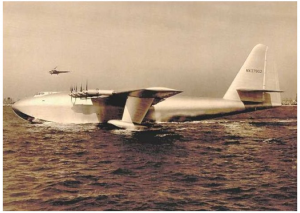
The Spruce Goose was Howard Hughes answer to military transport, but it was more useful as a party ship.
During World War II, the US military realized that they needed bigger transport planes to ferry equipment and supplies across the Atlantic. The government put out the request to US aircraft manufacturers, and Howard Hughes, of Hughes Aircraft, decided to respond.
There was a catch.
The aircraft couldn’t be made of metal, due to wartime rationing.
Howard Hughes was already rich and famous by the time he started the build. He was also already known for his eccentric and volatile personality. He took up the project to build the largest transport plane in the world as a personal quest. And he did it.
He named the aircraft the Hughes H-4 Hercules, and despite rumors that it was too large to fly, it did – on November 2, 1947, two years after the war was over.
Delays in design and construction had rendered it obsolete before it ever went into service.
The public called it the Spruce Goose, and considered it a grand folly by Hughes. But it was a remarkable aircraft and revered by aviation enthusiasts.
In 1980, the California Aero Club put the Spruce Goose on display in Long Beach, California. This is where Colonel C. J. Tippett comes in.
In the 1980s, my grandfather, Col. C. J. Tippett, was hosting a series of parties on behalf of the air force and state department for the foreign air attachés. These parties were a highlight of the air attaché circles, and promoted diplomacy and communication through channels that wouldn’t have been otherwise possible.
Tip, and his wife, Liz Whitney Tippett, had a reputation for fantastic, celebrity-studded parties in wonderous venues. The Spruce Goose was the perfect setting.
The cockpit of the Spruce Goose is usually available on tour by special ticket only, but for the party, it was all open. I know, because I was there. I was in college and the invitation to join my grandfather and legions of foreign air attaches was a treat. The Spruce Goose made it even better. I couldn’t believe the size of the flying boat, designed to take off and land on water. The wingspan was incredible, and the longest in aviation history.
I saw the Spruce Goose again, about thirty years later, at the Evergreen Aviation Museum in McMinnville, Oregon – only an hour away from my home in Portland. I toured it again, thinking of my grandfather and that party. The aircraft looked the same. Astonishingly huge.
Sitting in place, it has flown through time… unchanged.
It is one part of Howard Hughes legacy to aviation, the most visible and tangible to me. In our family legends, Tip had met Howard Hughes, and probably had some rousing discussions with him, but unfortunately, I have no documentation to prove it.
No letters, no stories in Tip’s memoir, which is almost ready for publication, and no photographs. But in the spirit of six degrees of separation, if the Spruce Goose counts as an entity, I can get to Howard Hughes in two!


